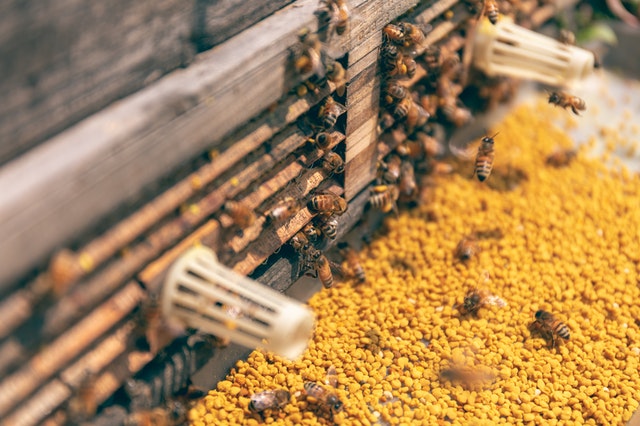
꽃에서 병까지, 벌들이 꿀을 만드는 방법 🐝 🍯
꿀벌은 매년 7,500만 파운드의 꿀을 생산하며, 많은 과일과 채소 작물, 견과류 및 카놀라와 같은 유채 씨앗의 수분을 담당합니다. 꿀벌만으로도 캐나다 경제에 46억 달러의 가치를 기여하고 있습니다.
꿀을 만드는 과정은 많은 사람들이 생각하는 것입니다. 결국, 벌들이 어떻게 그렇게 맛있는 것을 만들 수 있을까요? 벌들이 꿀을 만드는 방법을 설명하기 전에 왜 꿀을 만드는지 물어볼 가치가 있을지도 모릅니다.
"왜 벌들은 꿀을 만드는가?"
비록 꿀이 영양가 있고 맛있지만, 벌들은 인간의 소비를 위해 꿀을 만들지 않습니다. 사실, 꿀은 벌들이 자신을 먹이기 위해 만드는 것입니다. 꿀은 그들의 식량 공급원이며, 그들이 자라도록 돕기 위해 새끼들에게 주는 것입니다. 벌들이 꿀을 풍부하게 생산하는 이유는 꿀벌들이 꿀을 모으기 어려운 궂은 날씨와 꽃이 제한된 겨울철 동안 자신을 먹이기 위해서입니다.
봄과 여름에 꿀을 과잉 생산함으로써, 벌들은 그것을 저장하고 겨울 동안 전체 군체를 먹이는 데 사용할 수 있습니다. 이것이 양봉가들이 겨울 동안 벌들이 생존할 수 있도록 벌통에 충분한 꿀을 남겨두는 것이 중요한 이유입니다.
꿀은 어떻게 만들어지나요? 단계별 꿀 제조 과정
이제 벌들이 왜 꿀을 만드는지 알았으니, 그들이 실제로 어떻게 꿀을 만드는지 이야기할 수 있습니다. 그리고 이것은 정말로 놀라운 일입니다.
어쩌면 모를 수도 있는 사실은 모든 벌이 꿀을 만들 수 있는 것은 아니라는 것입니다. 꿀을 생산할 수 있는 것은 오직 꿀벌뿐입니다. 또 다른 흥미로운 사실은 한 마리의 일벌이 평생 동안 (참고로 약 6주입니다) '겨우' 티스푼의 12분의 1 정도의 꿀만 만든다는 것입니다. 이것이 바로 양봉가들이 수확할 수 있는 많은 양의 꿀을 생산하기 위해서는 전체 벌집이 필요하다는 이유입니다.
꿀 제조 과정에는 여러 단계가 포함되어 있습니다:
- 일벌들은 꿀을 모으기 위해 꽃을 찾아 벌집을 떠납니다. 그들은 보통 꿀과 꽃가루를 찾기 위해 벌집에서 약 4~5마일 정도를 이동합니다. 벌들은 그들의 흡관(관 모양의 입 부분)을 사용하여 꽃 안쪽에서 꿀을 빨아들입니다. 꿀벌은 보통 한 번의 여행에서 100개 이상의 꽃을 방문합니다. 수집된 꿀은 벌의 꿀 위에 저장되어 벌집으로 가져갈 준비가 됩니다.
- 벌집에서 다른 일벌들(집벌이라고도 함)은 꿀을 만들기 시작하기를 기다리고 있습니다. 채집벌들이 돌아오면, 그들은 꿀주머니에서 꿀을 집벌들에게 전달하고, 집벌들은 그것을 씹어서 다른 벌에게 전달합니다. 이 과정은 꿀이 묽은 꿀로 변할 때까지 계속됩니다.
- 꿀이 겨울 동안 저장되기 전에, 탈수 과정을 거쳐야 합니다. 씹는 과정에서 일부 물이 제거되지만, 이 단계에서는 여전히 너무 많은 물을 포함하고 있습니다. 벌들은 꿀을 벌집에 펼쳐 놓아 물이 증발할 수 있도록 합니다. 이 과정을 가속화하기 위해, 벌들은 꿀 근처에서 날개를 퍼덕이기 시작합니다. 이는 공기 흐름을 증가시켜 더 많은 물이 증발되도록 보장합니다.
- 물 함량이 20% 이하로 내려가면, 벌들은 마지막 단계인 벌집 밀랍으로 꿀을 덮는 작업을 시작할 수 있습니다. 꿀이 준비되고 물 함량이 적절한 수준에 도달하면, 벌들은 꿀을 벌집 세포에 넣고 그들의 복부 뒤쪽에 있는 분비선에서 분비한 밀랍으로 덮습니다. 벌집 세포를 덮는 것은 꿀을 신선하게 유지하는 데 도움이 됩니다.
'우리가 꿀을 가져가면 벌들은 굶주리나요?'
우리가 벌들이 주로 자신들을 위한 식량으로 꿀을 만든다는 것을 알고 있기 때문에, 인간이 꿀을 가져갈 때 벌들이 굶주리게 되는지에 대한 질문은 정당한 질문입니다.
네, 꿀벌 군집은 겨울 전에 너무 많은 꿀이 벌집에서 가져가면 굶어 죽을 수 있습니다. 안타깝게도, 이는 초보 양봉가들이 자주 저지르는 실수로, 특히 새로운 벌집이 충분한 저장량을 쌓을 시간이 없었을 때 그렇습니다.
경험이 많은 양봉가들은 새로운 벌통이 꿀 저장고를 확립하는 데 시간이 필요하다는 것을 알고 있으며, 따라서 첫 해에는 벌통에서 꿀을 거의 채취하지 않습니다. 겨울 동안 벌들에게 추가적인 먹이 공급원으로 설탕 시럽을 제공해야 할 수도 있습니다.
'벌이 꿀을 너무 많이 가질 수 있나요?'
벌집에서 꿀을 너무 많이 채취하면 벌집이 굶주리게 될 수 있지만, 꿀을 너무 적게 채취하거나 전혀 채취하지 않으면 어떻게 될까요?
과잉 꿀을 수확하지 않으면, 벌집은 곧 그 크기를 초과하게 됩니다. 꿀벌들은 군체의 이익을 위해 평생을 일하며, 이는 풍부한 꿀을 생산하는 것을 의미합니다. 꿀벌들은 먹이로 필요한 것보다 더 많은 꿀을 만들어, 꿀을 수집할 수 없을 때를 대비해 저장합니다. 그러나 꿀벌들은 과잉 생산하는 경향이 있어, 과잉 꿀을 수확하지 않으면 결국 꿀을 저장할 공간이 부족하게 됩니다.
벌들이 벌집에서 공간이 부족해지면, 그들은 어쩔 수 없이 군집을 이룰 것입니다.
꿀은 얼마나 자주 수확해야 하나요?
양봉을 처음 시작하는 사람들은 종종 너무 많은 꿀을 채취하여 겨울 동안 벌집에 충분한 식량을 남기지 않는 실수를 저지릅니다. 이를 염두에 두고, 벌집에서 꿀을 얼마나 자주 수확해야 하는지 아는 것이 중요합니다.
얼마나 자주 수확할 수 있는지에 대한 정해진 규칙은 없으며, 경험이 가장 확실한 답을 줄 것입니다. 얼마나 많은 꿀을 채취할 수 있는지는 실제로 당신의 벌들이 얼마나 생산하는지에 달려 있으며, 이는 다시 연중 시기, 날씨 조건, 벌통 근처의 꽃이 피는 식물의 수와 같은 여러 요인에 따라 달라질 것입니다.
대부분의 양봉업자들은 1년에 한두 번 꿀을 수확하며, 첫 해에는 거의 수확하지 않거나 전혀 수확하지 않습니다. 벌집에서 꿀을 수확할 때는 반드시 숙성되고 밀봉된 꿀만을 가져가야 하며, 일반적으로 프레임이 3/4 이상 찼을 때만 수확해야 합니다.
요약
꿀벌만이 꿀을 만들며, 이는 군체를 먹이기 위해서입니다. 그러나 꿀벌은 겨울 동안 꿀을 채집할 수 없는 시기에 충분한 식량을 확보하기 위해 과잉 생산하는 경향이 있습니다.
벌들은 꿀을 만들 때 단계별 과정을 따릅니다. 일벌들은 꿀을 모으기 위해 벌집을 떠납니다. 벌집으로 돌아오면, 꿀벌들은 꿀 위장에 저장된 꿀을 기다리고 있는 다른 벌들에게 전달합니다. 그러면 그 벌들은 꿀을 씹고 다른 벌들에게 전달하여 꿀로 변할 때까지 반복합니다.
그 후 꿀은 벌집 세포에 저장되고 신선도를 위해 밀랍으로 덮기 전에 탈수되어야 합니다.
벌들이 꿀을 자신들의 식량으로 사용하기 때문에, 양봉가들이 너무 많은 꿀을 가져가면 겨울 동안 벌집이 굶주릴 수 있어 주의가 필요합니다. 너무 적게 가져가면 벌집이 과밀해져서 벌들이 떼를 지어 이동할 수 있습니다.
OneRoot에서는 여러분과 사랑하는 이들에게 최고의 맛과 가장 깨끗한 제품을 제공하기 위해 노력하고 있습니다. 또한, 우리 지구와 모든 생명체를 위한 최상의 보살핌을 제공하기 위해 노력하고 있습니다. Organic Life Magazine은 최근 "벌들이 우리를 돌봐줍니다. 우리는 그들을 더 잘 돌봐야 합니다."라고 썼습니다. 우리는 전적으로 동의합니다. 여러분 자신을 돌보고, 벌들을 돌보고, 우리 지구를 돌보세요.
오늘 우리와 함께 지구를 돌보는 사명에 동참하세요. 프리미엄 유기농 꿀을 위해 OneRoot에서 쇼핑하세요.
https://www.sciencefocus.com/nature/how-do-bees-make-honey/
https://www.ontariohoney.ca/educators/the-honey-bee
https://en.wikipedia.org/wiki/Honey#Classification_by_packaging_and_processing

